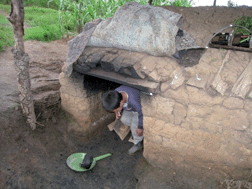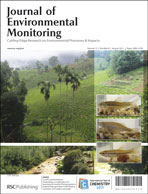Non-invasive measurement of carbon monoxide burden in Guatemalan children and adults following wood-fired temazcal (sauna-bath) use†
Abstract
The use of wood-fired steam baths, or temazcales, is a potentially dangerous source of CO exposure in Guatemalan Highland communities where adults and children use them regularly for bathing, relaxation, and healing purposes. Physical characteristics of children predispose them to absorb CO faster than adults, placing them at greater exposure and health risks. Efforts to quantify temazcal exposures across all age groups, however, have been hampered by the limitations in exposure measurement methods. In this pilot study we measured COHb levels in children and adults following use of the temazcal using three field-based, non-invasive CO measurement methods: CO-oximetry, exhaled breath, and by estimation of COHb using micro-environmental concentrations and time diaries. We then performed a brief comparison of methods. Average CO concentrations measured during temazcal use were 661 ± 503 ppm, approximately 10 times the 15 min WHO guideline. Average COHb levels for all participants ranged from 12–14% (max of 30%, min 2%), depending on the method. COHb levels measured in children were not significantly different from adults despite the fact that they spent 66% less time exposed. COHb measured by CO-oximetry and exhaled breath had good agreement, but precision of the former was affected substantially by random instrument error. The version of the field CO-oximeter device used in this pilot could be useful in screening for acute CO exposure events in children but may lack the precision for monitoring the burden from less extreme, but more day-to-day CO exposures (e.g. indoor solid


 Please wait while we load your content...
Please wait while we load your content...